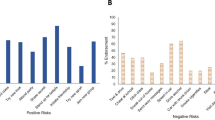Abstract
Risk was investigated from the subjective viewpoints of adolescents, with the aim of assessing adolescents' perceptions of what constitutes risky behavior and how risk behaviors and risk judgments relate. Participants were 570 school-based adolescents. Students named risky behaviors perceived as common to similarly aged peers, then rated level of engagement in these behaviors. The perceived positive and negative outcomes of risk were also nominated, and rated on perceived likelihood and desirability/undesirability. The sample viewed risky behaviors as smoking, drinking alcohol, dangerous driving, taking drugs, criminal behavior, sporting risks, antisocial behavior, minor rebellion, school-related risks, and sexual activity. Negative outcomes of risk were categorized as death, disablement, punishment, and social consequences. Payoffs included pleasure, material gain, and avoidance of negative outcomes. There was a consistent pattern of relationships between risk participation and outcome judgment, with perceived pleasantness and likelihood of positive outcomes, and unpleasantness of negative outcomes, strongly associated with behavior.
Similar content being viewed by others
References
Adler, N., Kegeles, S. M., and Genevro, J. L. (1992). Risk-taking and health. In Yates, J. F. (ed.),Risk-Taking Behavior. Wiley, New York.
Alexander, C. S., Kim, Y. J., Ensminger, M., Johnson, K. E., Smith, B. J., and Dolan, L. J. (1990). A measure of risk-taking for young adolescents: Reliability and validity assessments.J. Youth Adolesc. 19: 559–569.
Ajzen, I., and Fishbein, M. (1980).Understanding Attitudes and Predicting Social Behavior. Prentice-Hall, Englewood-Cliffs, NJ.
Ajzen, I., and Madden, T. J. (1986). Prediction of goal directed behavior: Attitudes, intentions, and perceived behavioral control.J. Exp. Social Psychol. 22: 453–474.
Arnett, J. (1992). Reckless behavior in adolescence: A developmental perspective.Develop. Rev. 12: 339–373.
Atkins, W J., Leder, G. C., O'Halloran, P. J., Pollard, G. H., and Taylor, P. (1991). Measuring risk-taking.Educat. Studies Math. 22: 297–308.
Baumrind, D. (1991). The influence of parenting style on adolescent competence and substance use.J. Early Adolesc. 11: 56–95.
Bell, N. J., and Bell, R. W. (eds.) (1993).Adolescent Risk Taking. Sage, Newbury Park, CA.
Benthin, A., Slovic, P., and Severson, H. (1993). A psychometric study of adolescent risk perception.J. Adolesc. 16: 153–168.
Beyth-Marom, R., Austin, L., Fischhoff, B., Palmgren, C., and Jacobs-Quadrel, M. (1993). Perceived consequences of risky behaviors: Adults and adolescents.Develop. Psychol. 29: 549–563.
Block, J., Block, J. H., and Keyes, S. (1988). Longitudinally foretelling drug usage in adolescence: Early childhood personality and environmental precursors.Child Develop. 59: 336–366.
Boldero, J., Moore, S., and Rosenthal, D. (1992). Intentions, context and safe sex: Australian adolescents' responses to AIDS.J. Appl. Social Psychol 22: 1375–1397.
Chassin, L., Presson, C. C., and Sherman, S. (1989). Constructive vs. destructive deviance in adolescent health-related behaviors.J. Youth Adolesc. 18: 245–262.
Gardner, W. (1993). A life-span rational-choice theory of risk-taking. In Bell, N. J., and Bell, R. W. (eds.),Adolescent Risk-Taking. Sage, Newbury Park, CA.
Gorsuch, R. L., and Butler, M. C. (1976). Initial drug abuse: A review of psychological factors.Psychol. Bull. 83: 120–137.
Jaccard, J., and Davidson, A. R. (1972). Toward an understanding of family planning behaviors: An initial investigation.J. Appl. Social Psychol. 2: 228–235.
Janz, N., and Becker, M. H. (1984). The Health Belief Model: A decade later.Health Educat. Quart. 11: 1–47.
Jessor, S. L., and Jessor, R. (1977).Problem Behavior and Psychosocial Development: A Longitudinal Study of Youth. Academic Press, New York.
Kandel, D. B. (1980). Drug and drinking behavior among youth.Ann. Rev. Sociol. 6: 235–285.
Lavery, B., and Siegel, A. W. (1993). Adolescent risk-taking: An analysis of problem behaviors in problem children.J. Exp. Child Psychol. 35: 277–294.
Levitt, M. Z., Selman, R. L., and Richmond, J. B. (1991). The psychosocial foundations of early adolescents' high-risk behavior: Implications for research and practice.J. Res. Adolesc. 1: 349–378.
Lyng, S. (1993). Dysfunctional risk-taking: Criminal behavior as edgework. In Bell, N. J., and Bell, R. W. (eds.)Adolescent Risk Taking. Sage, Newbury Park, CA.
Metzler, C. W., Noell, J., and Biglan, A. (1992). The validation of a construct of high-risk sexual behavior in heterosexual adults.J. Adolesc. Res. 7: 233–249.
Moore, S., and Rosenthal, D. (1992). Australian adolescents' perceptions of health related risks.J. Adolesc. Res. 7: 177–191.
Moore, S., and Rosenthal, D. (1993). Venturesomeness, impulsiveness, and risky behavior among older adolescents.Percep. Motor Skills 76: 98.
O'Connell, J. K., Price, J. H., Roberts, S. M., Jurs, S. G., and McKinley, R. (1985). Utilizing the health belief model to predict dieting and exercising behavior of obese and non-obese adolescents.Health Educat. Quart. 12: 343–351.
Rosenthal, D., Hall, C., and Moore, S. (1992). AIDS, adolescents and sexual risk-taking: A test of the Health Beliefs model.Austral. Psychol. 27: 166–171.
Tonkin, R. S. (1987). Adolescent risk-taking behavior.J. Adolesc. Health Care 8: 213–220.
Weisenberg, M., Kegeies, S. S., and Lund, A. K. (1980). Children's health beliefs and acceptance of a dental preventive activity.J. Health Social Behav. 229: 59–74.
Yates, J. F. (Ed.). (1992).Risk-Taking Behavior. Wiley, New York.
Author information
Authors and Affiliations
Additional information
This research was supported by the Australian Rotary Health Research Fund.
Received Ph.D. from Florida State University. Research interests: adolescent development, risk taking, and sexuality.
Received Ph.D. from Monash University. Research interests: adolescent development, emotional development, and families.
Rights and permissions
About this article
Cite this article
Moore, S., Gullone, E. Predicting adolescent risk behavior using a personalized cost-benefit analysis. J Youth Adolescence 25, 343–359 (1996). https://doi.org/10.1007/BF01537389
Received:
Accepted:
Issue Date:
DOI: https://doi.org/10.1007/BF01537389




